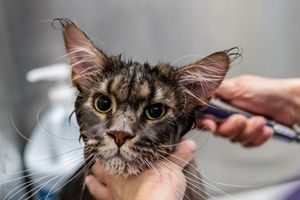WE SHIP CANADA-WIDE AND OFFER FREE LOCAL DELIVERY

Grooming
They say that dog’s think they clean themselves, but cats know they do. Well, this is almost true - cat’s are excellent self-groomers but even they need some help. The job of keeping your pets clean and groomed is different depending on their breed, coat type, and age.
Brushing
Regular brushing or your dog or cat helps to remove dirt and loose skin, spreads natural oils throughout their coats, prevents tangles and keeps their skin clean and irritant free. Many pets enjoy being brushed so it’s a nice time to bond with your pet and at the same time you can check for any ticks, fleas, flea dirt, or any emerging skin issues (see Skin & Coat - link). Brushing also gives you some control about where shedded hair goes.
Bathing
So this is a well-debated subject - how often does my pet need a bath? Well, it depends on your pet. Cat’s are great self-groomers but even they benefit from a bath, not least because it gives you the opportunity of really checking out your cat’s body for lumps and bumps. Dogs tend to need more regular bathing, not least because of their habit of rolling in mud, dust, and other more offensive things! Bathing is also an essential treatment should your pet get certain skin conditions or they have thick, long hair that is prone to tangles and matting. Regular bathing with good quality shampoo is a great habit to get your pets used to, not least because you reap the benefits of a sweet-smelling fur ball.
Dental Care
Care of your pet should ideally start from them being young so they get used to it. A healthy diet, good chews and chew toys go a long way towards dental health but tooth brushing is usually required. Gum disease can lead to infection, obsesses and even heart disease. Choose a pet-specific toothpaste (human toothpaste is poisonous to dogs if it contains xylitol), and get into a routine of regular cleaning.
Eye Care
Keep your pet’s eyes clear of ‘gunk’ by wiping gently with a damp cotton ball. Paying attention to your pet’s eyes during your grooming sessions will alert you early to any early signs of eye infections or issues. Long-haired breeds need the hair regularly trimmed around their eyes and any shampoo used in grooming should not be used around the eye area.
Ear Care
Always check your pet’s ears during your grooming sessions, especially for breeds that hair a lot of hair in their ears. Take advice from your vet about proper cleaning as it can be easy to probe too deeply. If you see any redness, swelling, discharge or an odour from the ear, seek medical advice. Be sure not to get water in your dogs ears during bath times.
Nail Care
Without regular care, a cat’s claws can grow into the pads of their feet causing pain, infection and lameness, a particular problem for older cats. Well-trimmed claws are also less likely to damage people, other pets, clothing and furniture. Dogs with short nails make less noise walking across hardwood floors and are less likely to get a nail caught or broken when out running.As a rule, your dog’s nails should be trimmed when they just about touch the floor when they walk. How often this is depends on the dog’s breed, age and lifestyle. Cats’ nails can also be cut regularly and, like dogs, it’s best to start them early, especially if you want to do the clipping yourself. Unless your pet is very comfortable with you doing it, get a professional groomer to clip them.

Vacation & Travel
Getting Ready for Travel
Going on vacation when you have a pet can be a traumatic event for both of you if you are not properly prepared. You may be travelling with your pet and staying in a cottage or pet-friendly hotel, or leaving your pet behind with a sitter or kennel - whatever the option, it is worth taking some time to get you both ready for what can be a relaxed and enjoyable time for everyone. Prepare your pet for travel.
Travelling With Your Pet
- Exercise your pet just before you go so they will be tired and sleep for a while.
- Plan regular breaks on the way and ensure your pet is properly restrained as you travel.
- Pre-pack snacks or meals and have plenty or water available.
- If you feed raw, perhaps consider taking some dehydrated food with you.
- If you are travelling for a long distance your pet may get car sick so be prepared for this with cleaning items. Frequent stops may reduce the risk of this.
- Always make sure your pet has I.D. on them in case they get separated from you.
- Take toys to keep your pet entertained once they arrive in their new holiday location.
- Check out specific airline requirements before you travel by air.
Leaving Your Pet at Home
Where will your pet stay? Will you have a pet sitter at your home? Or will they be staying at a sitter’s home or kennel? Consider these things:
- Meet the pet sitter or staff before you leave your pet to ask questions and give instructions about walking and feeding as well as any special requirements (it’s best to write this all down for them too). Take your pet to meet them too so they get to know them.
- Does your pet get separation anxiety? If it is serious, you should take steps well in advance to tackle this. Let your sitter know how long it’s OK to leave your pet alone.
- Consider calming solutions like a Thundershirt or supplements to help with anxiety.
- Try to remain calm and positive as you leave your pet - they will pick up on your stress.
- Send your pet with familiar items including their usual food and treats, a few favourite toys, a blanket, and perhaps an item of clothing that smells like you.
- Remember to take any medications your pet needs with instructions and your vet’s contact info.
Taking these preparatory steps will help you feel more confidant that all will be well while you are away so you can enjoy your vacation.

Struggling With Obesity
What do vets say?
According to veterinarians, overfeeding is the most common mistake pet owners make in feeding their dogs or cats. Weight management is cited most often by veterinarians as one of the most important things pet owners can do to increase the length of their pet’s life, yet fewer than 2 in 10 pet owners feed their pet(s) the amount recommended on the pet food package and they are more likely to choose what their pet likes to eat over what they should eat for their health.
How do I know if my pet is overweight?
The best way is to stand above pets and look down on them. You should be able to feel their ribs but not see them. If you can see them, they are too skinny. If you can’t see their ribs, and place your hands on the side of their chest and still can’t, they’re overweight.
Both dogs and cats should also have a nice taper at their waist (between the abdomen and where the hips go into the socket). If there is very little or none at all, they are too heavy and they’ll be oval shaped. You can also find advice online by looking at your pet’s Body Condition Score (BCS) where you can look at pictures of your type of pet and what they should look like.
Best of all is ask your vet what your pet’s healthy weight is and weigh them regularly. Most vets are quite happy for you to bring your larger pet to their clinic to be weighed on their special scale at no cost. This is also a good way to get your pet used to visiting the vets.
How is obesity bad for my pet?
According to the Canadian Veterinary Medical Association pet obesity can cause:
- A shorter life span
- Difficulty diagnosing other health disorders due to obesity
- Greater risk during surgery due to reduced lung function and/or decreased liver and kidney function. Obese pets also require more anaesthesia than pets who are a healthy weight.
- Greater potential for high blood pressure, which can include the risk of heart, kidney and blood vessel diseases.
- Increased chances of arthritis and spinal problems, as well as reduced mobility.
- Less endurance and more fatigue.
- Obese pets may be less able to fight off infections.
- Difficulty enduring hot weather and cooling down.
- Higher prevalence of skin problems.
- An increased risk of diabetes.
- Reduced reproductive success.
- Gastro-intestinal problems.
What Can I do to prevent obesity or help with weight loss?
Start with their food. Make sure you are feeding the correct portion size of a high quality food and incorporate treats into their daily allowance. Don’t leave food out - once they have eaten remove their bowl. Cat’s especially will eat out of boredom. Make them work for their food - use toys that you fill with treats so they eat more slowly and enjoy the ‘hunt’ for their food. Add more pet-safe fruit and vegetables to their meals or use these as their treats.
Exercise is, of course, essential to their physique. Indoor cats can easily suffer from weight problems as it’s harder for them to naturally get the exercise that outdoor cats get so you should spend time playing with them to ensure they are moving about enough. Dogs need regular exercise so arrange for a dog walker if you are leaving them for extended periods of time. Play time is also a great opportunity to exercise your dog (see Toys & Games For Boredom).

Bringing Home A New Pet
Adoption versus Breeder?
Before you decide on getting a new pet there really is a lot to consider. Adoption, or buying from a breeder? Cost? Commitment? Training? Will it fit with your lifestyle? Here are some things to think about before you make that step.
Adopting a pet is good in so many ways. If you get it from a responsible adoption organization it will come fully vaccinated and sterilized and will be cheaper than purchasing from a breeder. You should, however, understand that most animals for adoption will have had a life somewhere else and have a fully-fledged personality and set of experiences from Day 1. Find out as much of the pet’s history as you can and ask if you are able to foster the pet for a while before you commit to full adoption. This will allow you to see if they fit with you (and vice versa). Purchasing from a breeder will inevitably be more expensive. If they are selling pedigree dogs, ask to see the pedigree paperwork and go to see where they are keeping the animals in advance. Ideally go to a breeder that has been personally recommended to you by other owners of their dogs. Good breeders will interview YOU before they are happy to let you have one of their animals. Never buy a pet from an online ‘store’ such as Kijiji - you won’t know the history, or even if they are the real owners of the animal. There are plenty of well-respected animal shelters and rescues where you can find a furry companion.
Ask us about animal rescue centers
Cost & Commitment
Not only will you need to feed your new pet (hopefully a high quality food), but you should also factor in vet visits, grooming, boarding/care when on vacation, and all the things that come along with a pet such as beds, bowls, crates, etc.
You can speak with us for more information on a ‘starter pack’ of items you may need.
On top of the dollar price the commitment, especially in the early weeks of having your new pet, should not be underestimated. Dogs will need training ranging from house training to walking on leash, recall, etc. You may want to do this with a professional trainer or school. Young animals and adopted pets may need extra time with you until they get used to their new home. If you can’t dedicate this time then perhaps it’s not the right time to get a pet.
Introducing your new pet to your home.
Puppies and kittens are impressionable so often their early experiences will stay with them. Keep their introduction low key and quiet. If they are meeting young children prepare the kids beforehand to be calm. A place of refuge for them like a crate, pet carrier, or special location where they can go to relax is a good idea. If you already have pets be sure to keep giving them the attention they are used to and introduce them slowly, especially if you are bringing an older pet home.
Make your household pet-proof - buy them good quality toys, keep loose wires tidied and don’t leave anything that can be toxic to pets (some foods and plants) around. Anything that might be easily broken by a boisterous puppy, or shiny for a playful kitten should be removed. Also make sure that they are safely kept in the house/garden and there are no easy escape routes.
Find out what food your new pet has been eating and arrange to transition to a new food - ask us how to do this.
Register your pet with a vet so that they can remind you about vaccinations that may need to be done as well as have you on file in case of an emergency.
Finally - make sure you have ID on your pet, at least a tag with contact details and preferably have them microchipped.
We are here to give you advice on bringing your new pet home - don’t hesitate to contact us.

Caring For A Senior Pet
What can I do to help?
Like us, as your pet gets older they may need extra visits to a health care professional to check up on them. Pets ‘age’ at different rates depending on their breed, lifestyle and DNA but they often suffer from similar problems; they may gain weight (see Struggling With Obesity), have dental issues, struggle with arthritis, or develop a disease of some kind.
Things you can do:
Schedule in regular vet check-ups (at least once per year) to have a full examination. Often diseases are hard to spot in the early stages and your vet can take tests to look more thoroughly at their health.
Keep an eye on their diet. As they age they may benefit from supplements that help with bone and muscle strength. Consider increasing their fatty acids or giving them glucosamine and chondroitin for arthritis. Immunity boosters can also help them fight illnesses. They may also benefit from softer food and treats if their teeth are starting to trouble them.
If they develop kidney or heart issues make sure their diet is low in sodium and have their electrolytes checked by your vet.
Exercise your pet appropriately. This will help with their weight as well as their mental wellbeing. Provide steps or ramps to help them get in your car (or bed!) and consider rugs or carpeting on slippy floors for your arthritic pet. Keep them warm with winter coats and shoes and provide extra blankets; as their metabolism slows then so does their ability to keep themselves warm.
As with any health issue take advice from your vet about their care and treatment.
